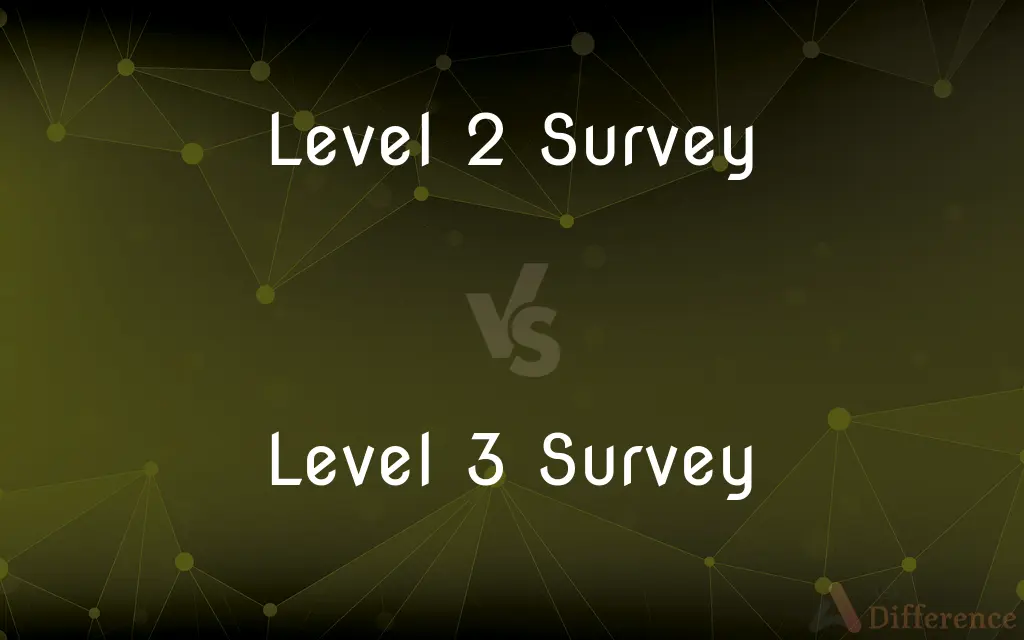Level 2 Survey vs. Level 3 Survey — What's the Difference?
By Urooj Arif & Fiza Rafique — Published on March 8, 2024
A Level 2 Survey offers a general overview of a property's condition, suitable for newer homes without visible issues, while a Level 3 Survey provides a detailed examination, recommended for older, larger, or altered properties needing repairs.

Difference Between Level 2 Survey and Level 3 Survey
Table of Contents
ADVERTISEMENT
Key Differences
Level 2 Surveys, also known as HomeBuyer Reports, are designed to identify any obvious major problems with a property, such as structural issues, dampness, and infestation, without being too invasive. They are generally recommended for properties that are in a reasonable condition and not more than 50 years old. This type of survey provides a clear and concise report, highlighting issues that could affect the property's value.
Level 3 Surveys, or Building Surveys, offer a comprehensive analysis of a property's state, including a thorough examination of its structure and condition. They are tailored for older, larger, or non-standard properties, especially those that have undergone significant alterations or are in need of repair. The surveyor will provide a detailed report that can include advice on repairs, estimated costs, and information on the materials used in the construction.
The scope of a Level 2 Survey is less invasive; it does not typically include an in-depth examination of areas that are difficult to access. In contrast, a Level 3 Survey involves a more thorough investigation, which may include looking under floors, above ceilings, and other areas that are not easily accessible, provided permission is granted and it's safe to do so.
A Level 2 Survey focuses on surface-level issues and provides a broad overview, making it more cost-effective and faster to complete than a Level 3 Survey. However, the depth and detail of a Level 3 Survey can provide peace of mind by uncovering potential issues that could require significant investment to repair.
Choosing between a Level 2 and Level 3 Survey depends on factors such as the age, type, and condition of the property, as well as the buyer's future plans for the property. A more detailed survey like a Level 3 is advisable if there are specific concerns about the property's condition or plans for major renovations.
ADVERTISEMENT
Comparison Chart
Purpose
Identifies visible major problems; suitable for relatively new, standard properties
Provides a detailed examination of the property's structure and condition; ideal for older, larger, or non-standard properties
Recommended for
Modern homes in reasonable condition
Older, complex, or significantly altered properties
Depth of Inspection
Non-invasive, focuses on obvious issues
Invasive, thorough investigation of accessible and hard-to-reach areas
Report Detail
Concise, highlighting issues affecting value
Detailed, with repair advice and potential costs
Cost
Generally less expensive
More expensive due to the depth of analysis
Duration
Faster to complete
Takes longer due to comprehensive examination
Best Used When
No specific concerns and the property is relatively straightforward
Concerns about the property's condition or when planning significant changes
Compare with Definitions
Level 2 Survey
A general assessment of a property's condition, highlighting major issues.
The Level 2 Survey identified dampness but found no structural concerns.
Level 3 Survey
Recommended for older or uniquely designed homes.
The historic Victorian house required a Level 3 Survey to assess its intricate details.
Level 2 Survey
Provides a clear report on property value implications.
The survey report outlined minor issues that wouldn't significantly affect the property's value.
Level 3 Survey
Provides a thorough report with repair advice and estimates.
The report included a breakdown of urgent repairs and their estimated costs.
Level 2 Survey
Non-invasive, focusing on easily accessible areas.
The surveyor examined visible areas without moving furniture or lifting floorboards.
Level 3 Survey
Ideal for properties needing significant work or renovation.
The Level 3 Survey informed the renovation plan for the dilapidated farmhouse.
Level 2 Survey
Cost-effective for relatively straightforward properties.
Given the home's recent construction, a Level 2 Survey was both sufficient and economical.
Level 3 Survey
A comprehensive examination of a property's overall structure and condition.
The Level 3 Survey revealed the need for roof repairs and electrical system updates.
Level 2 Survey
Suitable for newer homes with no visible problems.
The buyer opted for a Level 2 Survey for the modern townhouse.
Level 3 Survey
Involves detailed inspection, possibly including under floors and behind walls.
With permission, the surveyor inspected the attic and subfloor areas for signs of rot.
Common Curiosities
Why is a Level 3 Survey more expensive?
The higher cost reflects the survey's thoroughness, including detailed inspection of hard-to-reach areas and a comprehensive report with repair advice.
What's the main difference between a Level 2 and Level 3 Survey?
The main difference lies in the depth of the inspection and detail of the report; Level 2 is less detailed and for newer properties, while Level 3 is more comprehensive, for older or complex properties.
Can a Level 2 Survey uncover all potential issues?
While it can identify visible major issues, it might not uncover hidden problems due to its less invasive nature.
How do I decide which survey I need?
Consider the age, condition, and type of property, as well as any specific concerns or plans for renovation. Level 2 is suitable for newer, standard homes, while Level 3 is best for older, larger, or non-standard properties.
Can I attend the survey?
This depends on the surveyor's policy and the property owner's permission, but attending can provide direct insights and the opportunity to ask questions.
How long does each survey take to complete?
The time varies based on the property's size and condition. A Level 2 Survey is quicker, while a Level 3 Survey is more detailed and takes longer.
What if I plan to renovate the property?
If significant renovations are planned, a Level 3 Survey is advisable to ensure a thorough understanding of the property's condition and potential issues.
What happens if serious issues are found?
The survey report will detail any serious issues, allowing you to make informed decisions about proceeding with the purchase, negotiating the price, or addressing the issues.
Is a Level 3 Survey necessary for a relatively new but large property?
It may not be strictly necessary for a new property, but if the size or complexity of the home raises concerns, a Level 3 Survey could provide additional peace of mind.
What should I do if the survey reveals problems I'm not prepared to handle?
If significant issues are discovered, consider whether you're willing to undertake the necessary repairs or if you'd prefer to renegotiate the sale price, request the seller to make repairs, or even withdraw your offer.
Can a Level 2 Survey be upgraded to a Level 3 if issues are found?
Yes, if a Level 2 Survey uncovers problems that warrant a more detailed examination, you can subsequently commission a Level 3 Survey for a comprehensive assessment.
How detailed is the report from a Level 2 Survey compared to a Level 3 Survey?
A Level 2 Survey report is concise, highlighting significant issues and their implications on value. A Level 3 Survey report is more detailed, offering in-depth analysis, repair advice, and sometimes cost estimates.
Does the age of the property always dictate the level of survey needed?
Not always. While age is a significant factor, the condition of the property and any alterations or extensions also play crucial roles in deciding the level of survey needed.
How do I find a qualified surveyor for a Level 2 or Level 3 Survey?
Look for a chartered surveyor who is a member of a recognized professional body, such as the Royal Institution of Chartered Surveyors (RICS), ensuring they have the necessary qualifications and adhere to professional standards.
Are there any properties for which a Level 3 Survey is not suitable?
A Level 3 Survey is suitable for most types of properties, especially where detailed information on condition and structure is needed. It might be considered unnecessary for new builds or properties under warranty where a Level 2 Survey would suffice.
Share Your Discovery

Previous Comparison
POP vs. IMAP
Next Comparison
Psychiatrist vs. PsychologistAuthor Spotlight
Written by
Urooj ArifUrooj is a skilled content writer at Ask Difference, known for her exceptional ability to simplify complex topics into engaging and informative content. With a passion for research and a flair for clear, concise writing, she consistently delivers articles that resonate with our diverse audience.
Co-written by
Fiza RafiqueFiza Rafique is a skilled content writer at AskDifference.com, where she meticulously refines and enhances written pieces. Drawing from her vast editorial expertise, Fiza ensures clarity, accuracy, and precision in every article. Passionate about language, she continually seeks to elevate the quality of content for readers worldwide.














































